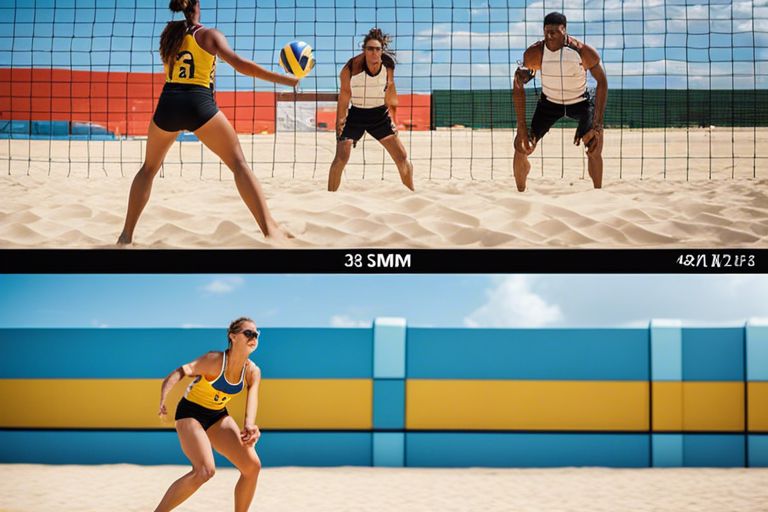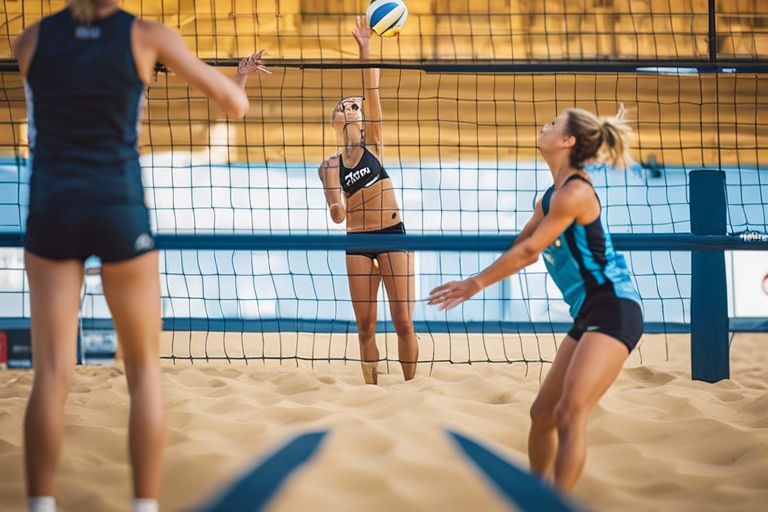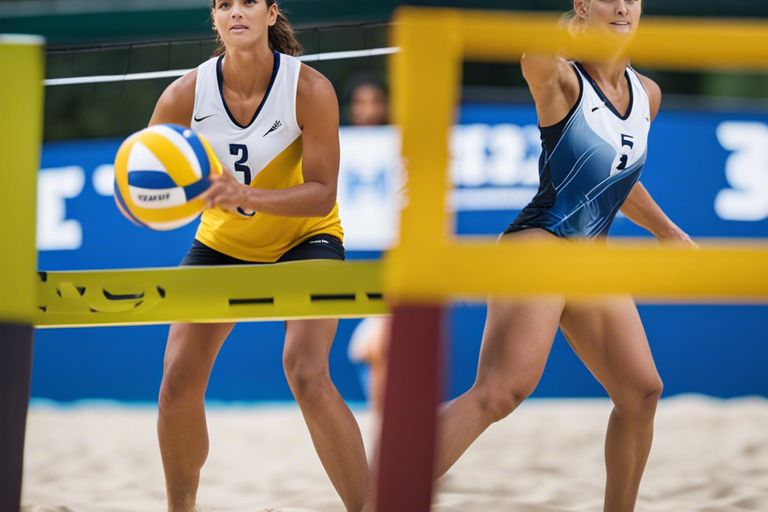Have you ever wondered how beach volleyball differs from its indoor counterpart? Differentiating between these two popular sports can reveal fascinating insights into the nuances of each game. From the playing surface to the team dynamics, there are several key distinctions that shape the unique experiences of beach and indoor volleyball. Let’s research into the specifics to uncover what sets these two versions of the sport apart.

Key Takeaways:
- Court Size: Beach volleyball courts are smaller, with a playing area measuring 8m x 8m compared to indoor volleyball courts which are larger at 9m x 18m.
- Number of Players: Beach volleyball teams consist of 2 players per side, whereas indoor volleyball teams have 6 players on the court at a time.
- Surface: Beach volleyball is played on sand, which affects movement, jumping, and diving techniques compared to indoor volleyball which is played on a hard court surface.
The Origins of Volleyball
The Birth of Indoor Volleyball
With the creation of volleyball in 1895 by William G. Morgan, a physical education director, a new sport was born that combined elements of basketball, baseball, tennis, and handball. This innovative game was initially called “Mintonette” before officially becoming known as volleyball. The sport quickly gained popularity for its fast-paced nature and teamwork-oriented gameplay.
The Evolution of Beach Volleyball
Volleyball took on a new form when beach volleyball emerged in the 1920s along the sunny coastlines of California. Unlike indoor volleyball, beach volleyball is played on sand with teams of two players each. This version of the sport became synonymous with laid-back beach culture, attracting both casual players and professional athletes alike.
Plus, beach volleyball has a different set of rules compared to indoor volleyball, requiring players to adapt their skills to account for factors like wind and uneven playing surfaces. The dynamic nature of beach volleyball adds an extra layer of excitement and challenge to the game, making it a unique and thrilling experience for both players and spectators.

Court Dimensions and Layout
Indoor Volleyball Courts
Court dimensions in indoor volleyball are standardized. The court is 18 meters long and 9 meters wide, with a 2.43-meter-high net in the middle. The court is divided into two equal square halves by the net, and each team occupies one half.
Your positioning on the court is crucial in indoor volleyball. Players are assigned specific roles and positions, such as setter, hitter, or libero, and must adhere to rotation rules. The boundaries are clearly marked, and players must stay within these lines during play.
Beach Volleyball Courts
For beach volleyball, the court size is smaller compared to indoor volleyball. A beach volleyball court is 16 meters long and 8 meters wide, with a 2.43-meter-high net just like indoor volleyball. However, the sand surface adds an element of challenge as players need to adjust their movements according to the softer and shifting terrain.
Beach volleyball courts have no defined boundaries like indoor courts. Players have more freedom to move around the sand area, and the natural environment adds an extra level of unpredictability and excitement to the game.
Layout: In beach volleyball, the court is typically surrounded by a safety perimeter of a minimum of 3 meters wide to ensure that players have enough space to play without the risk of colliding with obstacles or spectators.
Number of Players and Team Dynamics
Indoor Volleyball Teams
Teams in indoor volleyball consist of six players on each side of the net. This includes specific positions such as setters, hitters, blockers, liberos, and defensive specialists. Each player has a designated role and must work together seamlessly to execute plays effectively. The team dynamic in indoor volleyball is crucial, as players need to communicate well, understand each other’s strategies, and cover for one another in case of mistakes.
Beach Volleyball Pairs
On the other hand, beach volleyball is played in pairs, with only two players on each side. This leads to a more intimate and intense gameplay experience, as each player must cover the entire court on their own. Beach volleyball pairs rely heavily on cooperation, trust, and synergy between partners. Communication becomes even more critical in this setup, as there are only two players to handle all aspects of the game.
Dynamics between beach volleyball pairs are fascinating to watch, as the chemistry between players can greatly impact the outcome of the match. Partners need to anticipate each other’s moves, adapt quickly to changing situations, and provide unwavering support throughout the game. The dynamic between players in beach volleyball pairs is truly unique, emphasizing the strong bond and synchronization required to succeed in this exciting sport.

Scoring Systems and Game Length
Indoor Volleyball Scoring
To understand the differences between beach volleyball and indoor volleyball, you must first grasp the scoring systems used in each. In indoor volleyball, matches are typically played in a best-of-five sets format. Each set is played to 25 points, and a team must win by at least two points. If the match reaches a fifth set, it is played to 15 points.
Beach Volleyball Scoring
For beach volleyball, the scoring system is a bit different. Games are played in a best-of-three sets format, where each set is played to 21 points. Again, a team must win by at least two points. If a third set is needed to determine the winner, it is played to 15 points.
What makes beach volleyball scoring unique is that every point matters even more due to the shorter length of the games. With fewer points required to win each set, the margin for error is slim, and momentum can quickly shift from one team to the other. This adds an extra layer of excitement and intensity to beach volleyball matches, keeping both players and spectators on the edge of their seats.
Ball Characteristics and Materials
Indoor Volleyballs
Keep in mind that indoor volleyballs are typically heavier than beach volleyballs. They are made of leather, composite leather, or synthetic leather, which provides durability and control during indoor matches. The heavier weight of indoor volleyballs allows players to have more control and precision with their sets, spikes, and serves.
Beach Volleyballs
On the other hand, beach volleyballs are specifically designed for outdoor play on sand. They are lighter in weight compared to indoor volleyballs which is important for playing on the beach. Beach volleyballs are made of a softer and more water-resistant material to withstand the elements of outdoor play. The lighter weight and softer material allow players to have better control and feel when playing in the sand.
Ball manipulation plays a significant role in beach volleyball due to the lighter weight of the ball. It requires a different playing technique compared to indoor volleyball. The softer material of beach volleyballs affects the way the ball spins and floats through the air, making it crucial for players to adjust their techniques accordingly to be successful on the beach court.
Player Skills and Strategies
Indoor Volleyball Techniques
For indoor volleyball techniques, players need to focus on skills like power hitting, precise setting, and strong blocking. In indoor volleyball, the court is enclosed, which means that rallies can be longer and more intense. This requires players to have quick reflexes and strategic positioning to anticipate and react to the opponent’s moves.
Beach Volleyball Techniques
For beach volleyball techniques, players must adapt to playing on sand, which adds an extra challenge to the game. Since there are only two players per team in beach volleyball, each player must be proficient in all skills, including serving, digging, and spiking. The sand surface requires players to move differently and jump higher to overcome the resistance, making agility and endurance crucial in beach volleyball.
Strategies in beach volleyball involve effective communication and teamwork. With only two players on each side, it is necessary to have a strong partnership to cover the court efficiently and make split-second decisions. Beach volleyball also relies heavily on ball control and placement, as powerful hits may not be as effective on sand due to the slower nature of the game.
Volleyball is not just about strength and skill, but also about strategy and adaptability. Whether you prefer the fast-paced indoor game or the dynamic challenges of beach volleyball, honing your techniques and strategies will elevate your performance on the court.
Conclusion
Now you have a clearer understanding of how beach volleyball differs from indoor volleyball. Although they share many similarities, such as the basic rules and skills required, the playing environment and tactics used in each sport make them distinct from one another. Beach volleyball’s smaller court, fewer players per team, and the added element of sand all contribute to a unique and challenging experience that sets it apart from indoor volleyball.
Whether you prefer the fast-paced action of indoor volleyball or the dynamic, strategic play of beach volleyball, both sports offer their own set of thrills and challenges. Each variant requires specific skills, teamwork, and adaptability to excel, making them equally exciting to play and watch. So, the next time you hit the court, whether it’s indoors or on the beach, remember to embrace the differences that make each version of the sport special in its own way.
FAQ
Q: How is beach volleyball different than indoor volleyball?
A: Beach volleyball is played outdoors on a sand court, while indoor volleyball is played indoors on a hard court.
Q: What are the main differences in rules between beach and indoor volleyball?
A: In beach volleyball, teams consist of two players, while indoor volleyball teams have six players. Beach volleyball also allows players to touch the ball with any part of the body, while indoor volleyball has stricter rules on hand contact.
Q: How does the playing environment affect the game in beach volleyball compared to indoor volleyball?
A: The sand surface in beach volleyball makes movement more challenging and slower compared to the hard court in indoor volleyball. Players need to adjust their techniques and strategies to account for the different playing conditions in each version of the sport.




